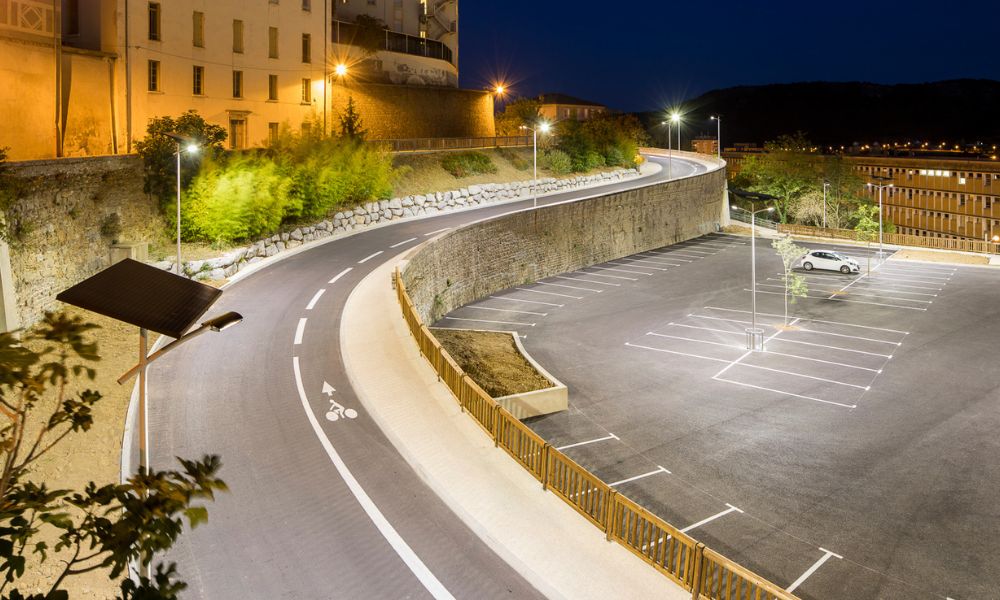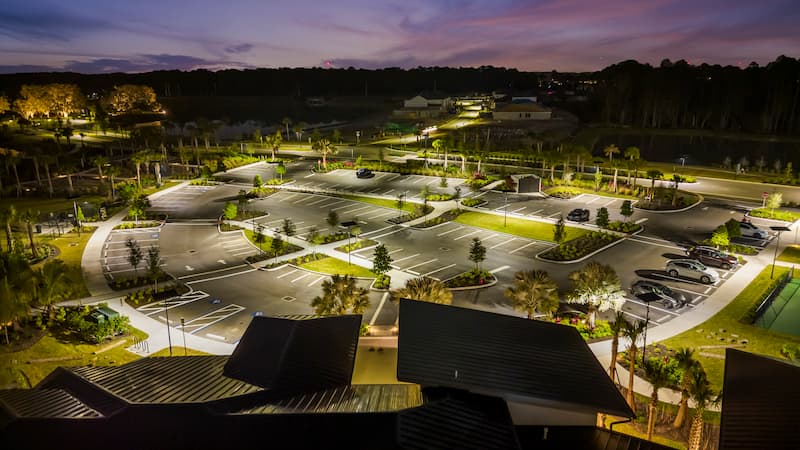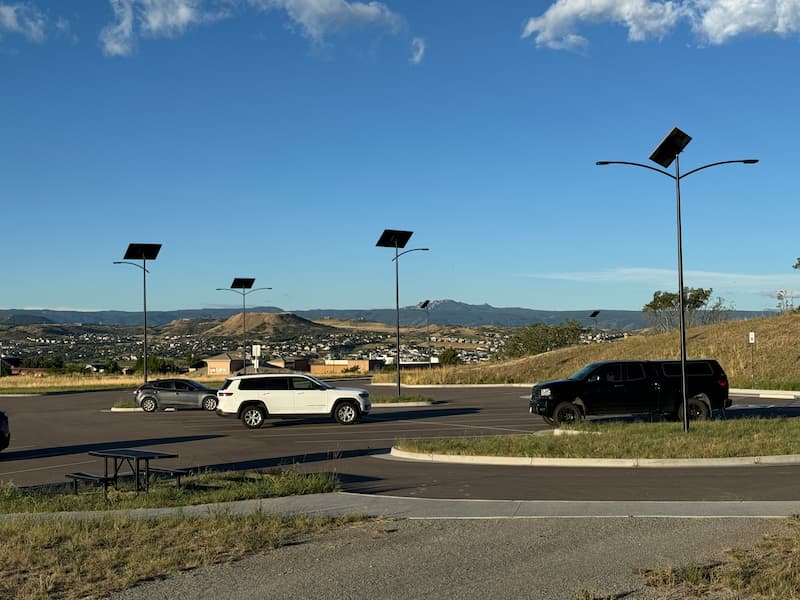Two Lighting Systems, One Big Decision
When it comes to lighting a parking lot, the goal is clear: create a safe, well-lit space that performs consistently and doesn’t drain resources over time. The question is how to get there—and whether to rely on a traditional wired lighting system or move toward a fully off-grid, solar-powered solution.
Both approaches use modern LED fixtures and can meet visibility standards. But beneath the surface, the infrastructure—and long-term impact—varies significantly.
The key difference is where the power comes from. Grid-tied lighting systems rely on buried conduit, electrical feeds, and utility service. Solar-powered systems operate independently, drawing and storing energy directly on site. That single shift affects not just installation, but how the system performs, what it costs, and how it holds up over time.
Choosing between the two often comes down to more than just price. It’s about infrastructure, resilience, and the long-term value built into the design.
Table of Contents
Upfront Costs That Tell Only Part of the Story
At first glance, traditional grid-powered lighting can appear less expensive. The fixtures themselves may cost less, and the technology is familiar to many contractors and crews. But the upfront budget rarely stops at the pole or the light.
Grid-tied systems often require:
- Trenching across pavement or landscaped areas
- Permits and inspections tied to electrical work
- Wiring, conduit, and junction boxes to connect each fixture
- Coordination with the utility provider for service connections
These added layers can quickly drive up both cost and complexity—especially on large lots, developed sites, or locations with buried infrastructure.
By contrast, solar parking lot lighting has a higher per-unit cost, but those units come self-contained. There’s no need for trenching, cabling, or electrical tie-ins. Installation is typically faster and less disruptive, and the price is more predictable because fewer trades and approvals are involved.
Systems like Fonroche SmartLights are designed with this streamlined approach in mind. Each pole arrives as a complete lighting unit—solar panel, battery, and fixture—ready to install without additional infrastructure.
While line items may differ, many projects find the all-in cost of solar and grid-tied systems closer than expected once infrastructure is factored in.

Fewer Moving Parts, Lower Long-Term Costs
Lighting systems aren’t just an upfront investment—they require upkeep. Over time, the cost of maintaining grid-tied systems can quietly add up through service calls, repairs, and utility bills.
Common issues include:
- Bulb or ballast failure in legacy fixtures
- Wiring degradation or moisture damage in underground conduit
- Service interruptions tied to utility outages
- Monthly electricity charges that increase with usage
Solar-powered lighting eliminates many of these vulnerabilities. With no underground wiring or grid connection, there are fewer components to fail. Power is generated and stored on-site, so even in storms or blackouts, the system stays online.
Fonroche SmartLights take this further with long-life NiMH batteries, smart energy management, and remote diagnostics—all designed for minimal maintenance over a 10+ year lifespan. No bulb replacements. No energy bills. And no surprise shutdowns.
Consistent Light, No Matter the Conditions
Lighting performance isn’t just about brightness—it’s about reliability. A system that works well in ideal weather but fails during storms or outages can’t be counted on when it matters most.
Traditional grid-tied lighting is vulnerable to:
- Power outages that leave entire lots in the dark
- Utility service delays during emergencies
- Inconsistent performance due to surges or system faults
Solar-powered systems avoid these risks by generating and storing their own energy. Each pole functions independently, so if one unit experiences an issue, the rest remain unaffected. There’s no central failure point.
Fonroche SmartLights are built for this kind of resilience. With intelligent battery management and tailored solar capture, they adapt to local conditions—whether it’s long winters, storm seasons, or fluctuating daylight. Smart diagnostics help monitor system health in real time, ensuring every unit delivers consistent performance.
Installation Without the Infrastructure Headache
Installing grid-tied lighting often means more than placing poles and fixtures. It requires cutting into pavement, routing conduit, coordinating with utilities, and waiting on inspections—all of which can extend project timelines and disrupt daily operations.
Typical challenges include:
- Trenching through finished surfaces like asphalt or concrete
- Navigating buried utilities and permitting delays
- Site closures or rerouting during installation
- Weather-related setbacks once ground is opened up
With solar lighting, the process is streamlined. Fonroche SmartLights are surface-mounted and completely self-contained. There’s no need for trenching or electrical connections, and most systems can be installed quickly with minimal site impact.
This makes solar especially valuable for:
- Sites with complex layouts or limited access
- Phased developments
- Upgrades to existing lots without service interruptions
By removing the most disruptive part of the installation process, Fonroche helps keep lighting projects on time—and far simpler to manage.

Which Pays Off Long-Term?
Initial costs may differ, but over time, solar-powered lighting often proves to be the better investment—especially when installation, maintenance, and energy use are considered as part of the full lifecycle.
Grid-tied systems come with recurring expenses: electricity bills, wiring repairs, and ongoing service needs. Solar systems eliminate those variables. With no power draw, fewer components, and long-life batteries, they offer predictable performance with minimal upkeep.
Fonroche SmartLights are built for this kind of longevity. Designed to run 365 nights a year for over a decade, they reduce operating costs while improving reliability, safety, and energy independence from day one.

